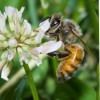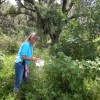 Protecting honey bees and other pollinators from pesticide impacts is important to the sustainability of agriculture. Consequently, pesticide applicators must determine if there is a clear hazard to managed or wild populations of bees. Potential exposure of bees to pesticides can vary greatly depending on the type of pesticide, formulation, application method, label restrictions, and other factors. The goal in using a pesticide is to achieve maximum benefit (success) with minimum negative impact, and these factors should always be considered in pesticide selection. This publication is written (1) to help assure the sustainability of both bees and agriculture by informing beekeepers, pesticide users, and the general public about the often complex relationship between pollinators (specifically bees) and pesticides, (2) to offer guidance for improved communication between beekeepers and pesticide users, (3) to offer pollinator risk-reducing strategies for growers and other applicators when using pesticides, and (4) to provide clarity in laws, labeling, and associated definitions. This 14-page fact sheet was written by J. D. Ellis, J. Klopchin, E. Buss, F. M. Fishel, W. H. Kern, C. Mannion, E. McAvoy, L. S. Osborne, M. Rogers, M. Sanford, H. Smith, P. Stansly, L. Stelinski, and S. Webb, and published by the UF Department of Entomology and Nematology, March 2014.
Protecting honey bees and other pollinators from pesticide impacts is important to the sustainability of agriculture. Consequently, pesticide applicators must determine if there is a clear hazard to managed or wild populations of bees. Potential exposure of bees to pesticides can vary greatly depending on the type of pesticide, formulation, application method, label restrictions, and other factors. The goal in using a pesticide is to achieve maximum benefit (success) with minimum negative impact, and these factors should always be considered in pesticide selection. This publication is written (1) to help assure the sustainability of both bees and agriculture by informing beekeepers, pesticide users, and the general public about the often complex relationship between pollinators (specifically bees) and pesticides, (2) to offer guidance for improved communication between beekeepers and pesticide users, (3) to offer pollinator risk-reducing strategies for growers and other applicators when using pesticides, and (4) to provide clarity in laws, labeling, and associated definitions. This 14-page fact sheet was written by J. D. Ellis, J. Klopchin, E. Buss, F. M. Fishel, W. H. Kern, C. Mannion, E. McAvoy, L. S. Osborne, M. Rogers, M. Sanford, H. Smith, P. Stansly, L. Stelinski, and S. Webb, and published by the UF Department of Entomology and Nematology, March 2014.
http://edis.ifas.ufl.edu/in1027
Tag: P.A. Stansly
Insecticides Currently Used on Vegetables (ENY419/IG018)
 This 12-page fact sheet lists many of the common insecticides currently labeled for use on vegetables in Florida. A number of new materials have been registered in the past few years or have had additional crops added to their labels. Some older organophosphate insecticides are now restricted to just a few crops, a result of recent rulings related to the Food Quality Protection Act. Changes continue, thus this listing may not be totally accurate at the time of printing. Written by S. E. Webb and P. A. Stansly, and published by the UF Department of Entomology and Nematology, August 2012.
This 12-page fact sheet lists many of the common insecticides currently labeled for use on vegetables in Florida. A number of new materials have been registered in the past few years or have had additional crops added to their labels. Some older organophosphate insecticides are now restricted to just a few crops, a result of recent rulings related to the Food Quality Protection Act. Changes continue, thus this listing may not be totally accurate at the time of printing. Written by S. E. Webb and P. A. Stansly, and published by the UF Department of Entomology and Nematology, August 2012.
http://edis.ifas.ufl.edu/ig018
Classical Biological Control of Tropical Soda Apple with Gratiana boliviana (ENY865/IN971)
 Tropical soda apple is a prickly shrub native to South America. First reported in Glades Co., Florida in 1988, it later spread to Georgia, Alabama, Louisiana, Texas, Mississippi, Tennessee, North Carolina, and South Carolina. It is a major problem in pastures and conservation areas. Negative impacts of tropical soda apple include reduction of cattle stocking rates, competition with native plants, and the costs associated with its control. Dense thickets of the weed also can disrupt the movement of wildlife. This 4-page fact sheet provides a summary of the major steps of the successful biological control program against tropical soda apple in Florida. The article covers the importance of the weed, identification and biology of the biological control agent, rearing and release efforts, establishment and impact, and efforts to communicate the outcomes of the program to stakeholders. Written by R. Diaz, J. Medal, K. Hibbard, A. Roda, A. Fox, S. Hight, P. Stansly, B. Sellers, J. Cuda and W. A. Overholt, and published by the UF Department of Entomology and Nematology, November 2012.
Tropical soda apple is a prickly shrub native to South America. First reported in Glades Co., Florida in 1988, it later spread to Georgia, Alabama, Louisiana, Texas, Mississippi, Tennessee, North Carolina, and South Carolina. It is a major problem in pastures and conservation areas. Negative impacts of tropical soda apple include reduction of cattle stocking rates, competition with native plants, and the costs associated with its control. Dense thickets of the weed also can disrupt the movement of wildlife. This 4-page fact sheet provides a summary of the major steps of the successful biological control program against tropical soda apple in Florida. The article covers the importance of the weed, identification and biology of the biological control agent, rearing and release efforts, establishment and impact, and efforts to communicate the outcomes of the program to stakeholders. Written by R. Diaz, J. Medal, K. Hibbard, A. Roda, A. Fox, S. Hight, P. Stansly, B. Sellers, J. Cuda and W. A. Overholt, and published by the UF Department of Entomology and Nematology, November 2012.
http://edis.ifas.ufl.edu/in971
Quick Sheet: Insecticides and Miticides Recommended for Use in the Florida Citrus Pest Management Guide (ENY854/IN807)
 This document is a two-page quick reference guide to citrus insecticides and miticides recommended in the Florida Citrus Pest Management Guide, their effects on important citrus pests, and their natural enemies. Written by M.E. Rogers, P.A. Stansly, L.L. Stelinski, and J.D. Yates, and published by the UF Department of Entomology and Nematology, January 2012.
This document is a two-page quick reference guide to citrus insecticides and miticides recommended in the Florida Citrus Pest Management Guide, their effects on important citrus pests, and their natural enemies. Written by M.E. Rogers, P.A. Stansly, L.L. Stelinski, and J.D. Yates, and published by the UF Department of Entomology and Nematology, January 2012.
http://edis.ifas.ufl.edu/in807
Managing Thrips and Tospoviruses in Tomato (ENY859/IN895)
 Several invasive species of thrips have established in Florida and are causing serious economic losses to vegetable, ornamental, and agronomic crops. Damage to crops results from thrips feeding and egg-laying injury, by the thrips vectoring of plant diseases, the cost of using control tactics, and the loss of pesticides due to resistance. This 12-page fact sheet describes the biology and ecology of thrips and tomato spotted wilt virus, and recommends a management program. Written by Joe Funderburk, Stuart Reitz, Steve Olson, Phil Stansly, Hugh Smith, Gene McAvoy, Ozan Demirozer, Crystal Snodgrass, Mathews Paret, and Norm Leppla, and published by the UF Department of Entomology and Nematology, August 2011.
Several invasive species of thrips have established in Florida and are causing serious economic losses to vegetable, ornamental, and agronomic crops. Damage to crops results from thrips feeding and egg-laying injury, by the thrips vectoring of plant diseases, the cost of using control tactics, and the loss of pesticides due to resistance. This 12-page fact sheet describes the biology and ecology of thrips and tomato spotted wilt virus, and recommends a management program. Written by Joe Funderburk, Stuart Reitz, Steve Olson, Phil Stansly, Hugh Smith, Gene McAvoy, Ozan Demirozer, Crystal Snodgrass, Mathews Paret, and Norm Leppla, and published by the UF Department of Entomology and Nematology, August 2011.
http://edis.ifas.ufl.edu/in895
Recommendations for Management of Whiteflies, Whitefly-transmitted viruses, and Insecticide Resistance for Production of Cucurbit Crops in Florida (EENY478/IN871)
 Until recently, squash has been the only cucurbit crop seriously affected by the B biotype of the sweetpotato whitefly, also known as the silverleaf whitefly, because of the silverleaf disorder induced by feeding of the immature stages (nymphs). However, three viruses transmitted by the whitefly have been identified in watermelon, muskmelon, and squash in Florida since 2004, making whitefly management a priority for most cucurbits. This 8-page fact sheet details the current UF/IFAS recommendations for managing whitefly-transmitted viruses and for delaying the development of resistance to insecticides in the whitefly vector. Published by the UF Department of Entomology and Nematology, July 2011.
Until recently, squash has been the only cucurbit crop seriously affected by the B biotype of the sweetpotato whitefly, also known as the silverleaf whitefly, because of the silverleaf disorder induced by feeding of the immature stages (nymphs). However, three viruses transmitted by the whitefly have been identified in watermelon, muskmelon, and squash in Florida since 2004, making whitefly management a priority for most cucurbits. This 8-page fact sheet details the current UF/IFAS recommendations for managing whitefly-transmitted viruses and for delaying the development of resistance to insecticides in the whitefly vector. Published by the UF Department of Entomology and Nematology, July 2011.
http://edis.ifas.ufl.edu/in871
Sampling for Asian citrus psyllid (ACP) in Florida (ENY857/IN867)
Three techniques are currently in use to sample adult Asian citrus psyllids (ACP). This 7-page illustrated fact sheet by H. A. Arevalo and P. A. Stansly discusses the strengths and weaknesses of each and makes recommendations for routine monitoring of ACP for management purposes. Includes references. Published by the UF Department of Entomology and Nematology, September 2010.
http://edis.ifas.ufl.edu/in867
ENY658/IN401 Managing Thrips in Pepper and Eggplant
Revised! ENY-658, a 6-page illustrated fact sheet by Joe Funderburk, Stuart Reitz, Phil Stansly, Dave Schuster, Greg Nuessly, and Norm Leppla, provides pepper and eggplant growers with management information for this serious pest of ornamental, vegetable and fruit crops in the field and greenhouse — biology and ecology, tomato spotted wilt and management programs. Includes references. Published by the UF Department of Entomology and Nematology, October 2009.
http://edis.ifas.ufl.edu/IN401
ENY-854/IN807 Quick Sheet: Insecticides and Miticides Recommended for Use in the Florida Citrus Pest Management Guide
Revised! ENY-854, a 2-page illustrated quick reference guide by M.E. Rogers, P.A. Stansly, L.L. Stelinski, and J.D. Yates, lists citrus insecticides and miticides recommended in the Florida Citrus Pest Management Guide, their effects on important citrus pests, and their natural enemies. Published by the UF Department of Entomology and Nematology, December 2008.
http://edis.ifas.ufl.edu/IN807